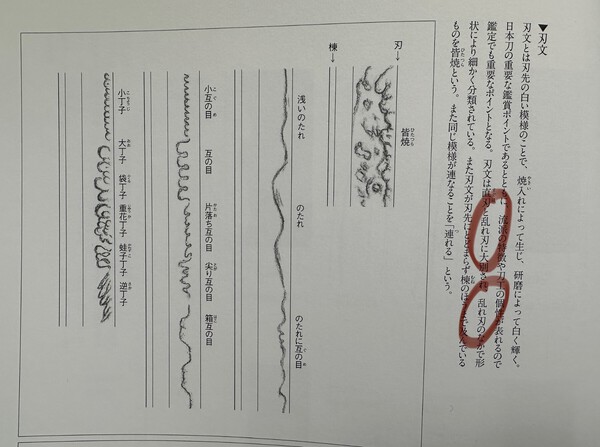-
Posts
1,929 -
Joined
-
Last visited
-
Days Won
22
Content Type
Profiles
Forums
Events
Store
Downloads
Gallery
Everything posted by Gakusee
-
Jacques, we went through this already. Refer to my post above with the excerpt from the Sano museum book, by the highly renowned but sadly now late Watanabe sensei, which splits hamon types into suguha and midareba. Written in both Japanese and English for you. End of argument. We are wasting time and effort and precious life energy.
-
Are we discussing this image? I would describe it as predominantly sugu-gunome in monouchi with some notare areas and with nezumi ashi. [But depending on in-hand examination, one could interpret some of the horizontal hataraki as kinsuji]. The lower part is gunome midare interspersed with choji midare, togari, yo and ashi. [And again, depending on in-hand examination, some of the areas of nie in the hamon could be areas of shimi]
-
BA or also pronounced Ha in other conjunctions and as in the word Hamon. Hardened sharp edge Midare: irregular
-
“Sussed” or not, Alex, it is still amusing to engage dialectically with Jacques just to disprove some of his grandiloquent statements. He is often right in his views but sometimes they could be very extreme.
-
one has to love you for the comical effect, Jacques, like a pantomime villain…. As I said, translation is ChatGPT for those who cannot read and understand Japanese. I appended the original Japanese text and as you know it says exactly that…. Of course, you are not commenting about the key point, namely that Watanabe sensei differentiated between suguha and midare as the principal types of hamon and instead you choose to digress….
-
As Jussi highlighted, Munetsugu is the one who signed katana mei. But even not mainline, he is still a Hizen smith. Another rare bird is Muneyasu (student of Munetsugu I think) - fewer swords of his are around and also he signed both ways. And just to preempt Jacques, he is a Hizen smith and there are connections with the Nabeshima daimyo.
-
Have not checked thread, but did anyone recommend to you Markus Sesko’s Tosogu Classroom? If not, I think both you and Dee will benefit from it.
-
Oh, Jacques, why does it have to be so difficult? I patiently waited and resisted throughout all the pontificatory edification as I agree with the concept that people need to master the basics. But a bit more humility and grace will serve us all well. Midareba (irregular) is a type of hamon, it has always been and will always be. Of course, it is preferable to elaborate what type of midare we are talking about: gunome midare or notare midare etc but sometimes the hamon is simply so all over the place and composite that one part is more choji heavy, another part is more notate, another might be gunome. Whatever is most prevalent will normally precede the term “midare” so you find descriptions such as “choji midare with gunome elements at the base” or “notare midare trending to ….” Etc. Again - please. You have a lot to give and contribute but we are all learning still…. Even after 20-25-40-50 years or whatever in the hobby we are still all beginners. ———————————————————— 刃文とは刃先の白い模様のことで、焼入れによって生じ、研磨によって白く輝く。 日本刀の重要な鑑賞ポイントであるとともに、流派の特徴や刀工の個性が表れるので、 鑑定でも重要なポイントになる。刃文は直刃と乱刃に大別され、乱れ刃の中でも形状によって細かく分類される。 また刀文が刃文にとどまらず棟のほうまで及んでいるものを棟焼という。また同様に模様が連なることを連れるという。 English Translation: The term “hamon” refers to the white patterns along the edge of the blade, which are created through the quenching process and made to shine brightly through polishing. Hamon is not only a crucial point of appreciation for Japanese swords, but it also reflects the characteristics of specific schools and the individuality of the swordsmiths, making it an important feature in sword appraisal. Hamon is broadly classified into straight patterns (suguha) and irregular patterns (midareba), with the irregular patterns further subdivided based on their specific shapes. Additionally, when the hamon extends beyond the blade edge to the spine of the sword, it is referred to as muneyaki (spine tempering). Similarly, when patterns continue seamlessly, it is called tsureru (continuation of patterns). Copyright: The Great Masterpieces of Japanese Sword (Watanabe Taeko, Sano Museum) Translation: ChatGPT
-
You should buy Mike Y at least a drink for that service He did pull one there…. Well, Jacques, back then at the DTI it did not have the sayagaki. But of course it had the Juyo paper, one could handle it in person and discuss with other people (if in doubt) and Miyoga Jr san. So, these are indeed pretty much ideal circumstances for someone who is perhaps not too confident. All in all well done again! Enjoy it and learn from it - it has a lot to offer at all levels of scholarship.
-
yes Brian, it is a gorgeous blade. ATM was lucky I only came for the second DTI day and looked at it too late …. Well done on an excellent sword at excellent price. To me, that was the “steal” of the show in terms of quality per dollar basis.
-
Only decorative and in homage to historic armours. Not actual date of relevance to this.
-

A word about amateur polishing
Gakusee replied to Brian's topic in General Nihonto Related Discussion
Amusing thread… I debated mentally whether to chime in or not (with the passage of time I more and more tend to just read and tolerate things I disagree with, since life and mental health are more important…) @Dan tsuba Tsuba Iconoclast Dan: I will only say here that treasures can be found on Ebay by those who have the knowledge to do so. I have two friends who have found very high level blades by top saijo Koto smiths on that marketplace. Personally, I have not managed on Ebay but have had some modest success dabbling on Yahoo Japan (even more treacherous…) Have a read of this thread here: This is probably before your time on NMB….Anyway, the knowledge possessed by the protagonist led him to acquire a masterpiece in this auction, have a window opened by a polisher and then sent to Japan for top-level restoration. The blade went on to get Juyo etc etc. The same I think happened to another one in the same auction…. Years later another friend found on Ebay a nice tachi, etc. I see various people trying their hand at “removing rust”. I try to discourage it but people often have their own pre-formed inveterate views, which cannot be altered. It is true that there are low-value swords which will probably never be restored professionally and will probably languish in a sad state. One could strip the active rust with choji oil etc, perhaps get a window done….etc Newcomers in particular should be discouraged from such attempts, despite their being skilled in other hobbies, having a dab hand at other handicrafts etc. It is as simple as that. -
Well done Manuel, very skillful restoration
-
This is a Tokuju sword of the highest class and looks even better in hand.
-
Wonderful, Brano! Thanks for sharing with everyone here.
-
Get better soon.
-
Life member of the Honbu in Japan and supporter of the EB, who are an amazing group too.
-
Wow, lovely mini museum Gary! Indeed this is beyond most would call merely a collection. What is your approach - sengoku period to early Edo?
-
Thank you for posting it, Gary. It is always enjoyable to see high-quality swords from time to time here. Oftentimes, the majority of the posts have the low-end starter blades which newcomers enquire about, unless people post about militaria shows etc. That is normal and understood but blades like yours are a rare treat. Not much activity, hamon etc can be seen here apart from the Nanbokucho kissaki in this stout blade. Interesting, unusual horimono too. Could you please clarify: is this kinzogan or kinpun mei? Unfortunately I cannot see the detail on my mobile and the eyes are not what they used to be. Thanks again.
-
-
The issue perhaps, Jussi, is that you like oversized swords, which at that size might not necessarily be the most refined? I have seen very few large swords that have the fine jigane and complex high quality hamon I like….Usually the longer and larger, the less interesting to me, unless they are ubu zaimei top Heian or Kamakura blade by one of the better smiths - usually top (ko) Bizen. The best sword in my view is the OKanehira. Huge, but with the finest craftsmanship from top to bottom. So, I attach a few snaps of it. There is not forging flaw over 80cm+, very wide and meaty blade - sprinkled with konie in the “wettest” possibly way

















